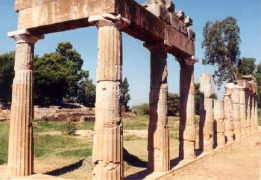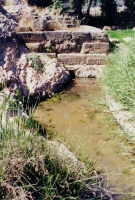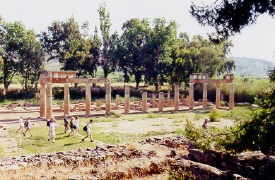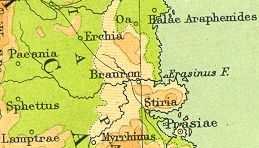

About halfway up the eastern Attic coastline, the Erasinos "river" flows into a sheltered bay (
photo
), well known for its beauty (Porto Rafti). About a kilometer
and a half from the sea lies the only attraction of the area, the Sanctuary
of Artemis Brauronia. The site was well known in antiquity as Iphigeneia
supposedly brought to Brauron an image of Artemis, which she stole from
Tauris with Orestes (Euripides, "Iphigeneia in Tauris"
1446-1467
). Pausanias also briefly describes the story and tells us that the image
was brought here, (
1.33.1
), but he offers little else. The rituals that took place at Brauron
are complex but we know that Artemis was worshiped here as the protectress
of childbirth. But this wasn't her only role at the site. Every
four years the festival, Brauronia, was held where Attic girls from five
to ten (known as the "Arktoi") dressed in saffron robes and even as bears
at points during the ritual which included the dedication of objects and
games such as races. Too much is still unknown about the rites for
someone as uninitiated as myself to further confuse the goings on.
I will refer you to the sites listed below which may sate your hunger for
further knowledge of the rituals and concern myself with the site description
below.
"river" flows into a sheltered bay (
photo
), well known for its beauty (Porto Rafti). About a kilometer
and a half from the sea lies the only attraction of the area, the Sanctuary
of Artemis Brauronia. The site was well known in antiquity as Iphigeneia
supposedly brought to Brauron an image of Artemis, which she stole from
Tauris with Orestes (Euripides, "Iphigeneia in Tauris"
1446-1467
). Pausanias also briefly describes the story and tells us that the image
was brought here, (
1.33.1
), but he offers little else. The rituals that took place at Brauron
are complex but we know that Artemis was worshiped here as the protectress
of childbirth. But this wasn't her only role at the site. Every
four years the festival, Brauronia, was held where Attic girls from five
to ten (known as the "Arktoi") dressed in saffron robes and even as bears
at points during the ritual which included the dedication of objects and
games such as races. Too much is still unknown about the rites for
someone as uninitiated as myself to further confuse the goings on.
I will refer you to the sites listed below which may sate your hunger for
further knowledge of the rituals and concern myself with the site description
below.
Sanctuary of Artemis Brauronia
A cave in the side of the acropolis was used as
a shrine to Iphigeneia in the site's earliest years, but in the 5C BC, the
roof fell in. The cave, at that time, was generally known as the Tomb
of Iphigeneia and it does seem as if other nearby tombs belong to the priestesses
of Artemis.
In front of the cave a Doric Temple was constructed
in the 5C BC, but only the cuttings of the foundations and some foundation
blocks remain today (seen in foreground of photo at bottom). Directly
between the temple and the rising hill of the acropolis, you can easily
find the "holy stairs" that Euripides mentions. The temple was
destroyed during the Persian invasion of 480 B.C. and the cult statue (possibly
still the original one?) was reportedly carried off to Susa.
Beneath the temple the Sacred Spring, which still
flows today, is found, emerging from the edge of the temple's foundations
(see photo to the left). In  the deep hole at the spring's mouth were found numerous vases, figurines,
mirrors and jewelry which had been dedicated to Artemis and thrown into the
water. Many of these priceless dedications are on display at the nearby
museum, some of the most intriguing pieces in the collection there.
the deep hole at the spring's mouth were found numerous vases, figurines,
mirrors and jewelry which had been dedicated to Artemis and thrown into the
water. Many of these priceless dedications are on display at the nearby
museum, some of the most intriguing pieces in the collection there.
The large Pi-shaped stoa (never finished) that
most people associate the site with today was constructed before 416 BC.
The building contained nine dining rooms (symposia) where ritual dining took
place. You can still see the holes in the stone where the iron legs of the
couches fitted into the floor, at regularly set intervals so that the doorway
to each room was always a little off center. This actually maximized
the number of couches that could fit in each room (7 each here). Remains
of the small tables that sat before each couch are also visible (look for
the big slabs on blocks in each room). The doorways themselves are also
interesting and you can still pick out the bronze fittings where the doors' "hinges" fit into the stone. Behind
the dining rooms, leading from the bridge (discussed below) along the rear
of the stoa, was a corridor lined with wooden boards (post holes still visible
in some places in the stone) where the dedicated garments of women who died
in childbirth were hung. This corridor was the actual entrance to the
sanctuary. A large wall would have prohibited entrance or even a view
of the sanctuary without first rounding the back of the stoa and entering
on the side towards the bay. The stoa was knocked over in the 4th century
B.C. when floods rushed through the sanctuary. This preserved much of
the architecture, but quite a bit was uncovered and used in the construction
of a 6th cent. Christian basilica, 500m. W of the sanctuary.
the bronze fittings where the doors' "hinges" fit into the stone. Behind
the dining rooms, leading from the bridge (discussed below) along the rear
of the stoa, was a corridor lined with wooden boards (post holes still visible
in some places in the stone) where the dedicated garments of women who died
in childbirth were hung. This corridor was the actual entrance to the
sanctuary. A large wall would have prohibited entrance or even a view
of the sanctuary without first rounding the back of the stoa and entering
on the side towards the bay. The stoa was knocked over in the 4th century
B.C. when floods rushed through the sanctuary. This preserved much of
the architecture, but quite a bit was uncovered and used in the construction
of a 6th cent. Christian basilica, 500m. W of the sanctuary.
Immediately outside the NW edge of the sanctuary, remains
of a classical bridge can still be found. The bridge is in quite
good shape considering its age. This is supposedly the only bridge from
classical times still in working condition. The span it crosses is
really little more than a marshy creek, a few feet deep and about 20 feet
long, but it is hard to discern in the summer since the weeds from the creek
bed keep the area covered over. To get a better idea of the bridge's location,
look at this aerial view from Perseus (
photo
). The bridge is clearly seen in the lower right hand corner. If you
make it to the site, don't miss the opportunity to go find this little known
jewel.
Sorry I don't have a detailed bibliography on this site, but I didn't get one for Brauron and I don't have time to look them up right now.
Getting there
 As for modern practicalities, there is not much to say
here. Current museum hours and admission rates (as well as those for the site
itself) can be found along with the up to date phone numbers you will need
on the first two links below so I won't repeat them here. If you don't
have a car, you'll probably have to take a bus from Athens (#304 or #305
from the Thession metro station, just W of the agora used to make the run).
This should drop you off at "Artemi", about 2 kilometers from the site, not
too far away and definitely achievable for those adventurers among you.
You will just need to be careful that the bus drops you off where you want
it to. I would buy a good map of Attica and pay close attention, maybe asking
the driver or pointing to the place on the map when you get on. The
museum should be more conspicuous than the site itself from the road.
It is located just around the acropolis, a kilometer or so away. My
"Rough Guide" says there is a single taverna located halfway between the
stop for the buses and the site but I don't know if it's still open or not.
As for modern practicalities, there is not much to say
here. Current museum hours and admission rates (as well as those for the site
itself) can be found along with the up to date phone numbers you will need
on the first two links below so I won't repeat them here. If you don't
have a car, you'll probably have to take a bus from Athens (#304 or #305
from the Thession metro station, just W of the agora used to make the run).
This should drop you off at "Artemi", about 2 kilometers from the site, not
too far away and definitely achievable for those adventurers among you.
You will just need to be careful that the bus drops you off where you want
it to. I would buy a good map of Attica and pay close attention, maybe asking
the driver or pointing to the place on the map when you get on. The
museum should be more conspicuous than the site itself from the road.
It is located just around the acropolis, a kilometer or so away. My
"Rough Guide" says there is a single taverna located halfway between the
stop for the buses and the site but I don't know if it's still open or not.
I would like to thank Bob Bridges for his explanations
and tour of this site.